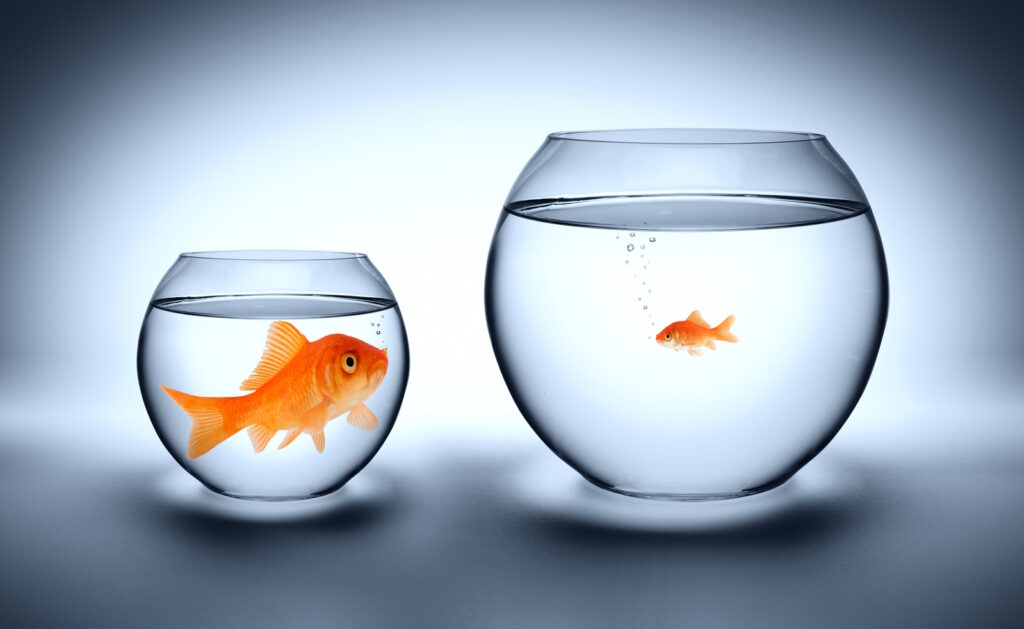All Anne* has thought about lately is finding a safe and effective way to overcome her painfully large fibroids and reclaim her life. What started as mild discomfort 18 months or so ago has become debilitating pelvic pain and irregular menstrual bleeding so heavy that she wears two pads for protection. Clearly, she needs help. But after receiving contradictory information regarding surgical vs. non-surgical fibroid removal, she’s now questioning her options.
Excitedly she read about a minimally invasive fibroid treatment called uterine fibroid embolization (UFE). However, she was told by her doctor that she wasn’t a candidate because her fibroids were too large and that she should have a hysterectomy. Her doctor also said UFE is as risky as surgery, which contradicted what she had read.
Does size really matter with large fibroids and effective intervention? Is there a size limit with UFE? Is UFE as risky as surgery? In a word—No. It’s a myth that UFE can’t handle large fibroids. Surprisingly, some doctors who do not perform UFE think this and advise their patients accordingly. In fact, UFE is one of the top procedures for handling large fibroids. It is often used to safely shrink large fibroids before fibroid removal surgery to ensure a more successful outcome.
Despite all we’ve learned over the years about fibroids—including types, symptoms, who’s at risk, treatment options, and the steps women can take toward relief—misinformation continues to run rampant. As a result, many women choose to suffer in silence. While every woman’s fibroid situation is unique, safe and effective non-surgical options like UFE treat even large fibroids. It’s also worth noting that symptom relief isn’t necessarily dictated by volume reduction. It can also depend on whether the fibroid is alive or dead. Knowing this is the best way for women like Anne to regain their confidence, get help, and live symptom-free.
Are You Experiencing Symptoms of Large Fibroids?
- Heavy menstrual bleeding
- Debilitating cramps, pelvic pain, and pressure
- Periods that last longer than a week
- Pain during sex
- Back or leg pain
- Urinary frequency
- Excessive fatigue
- Weight gain or bloating and swelling in the abdomen
- Constipation, diarrhea, and rectum discomfort

How Serious Are Large Fibroids?
Uterine fibroids are non-cancerous growths that develop from muscle tissue of the uterus. Research estimates that 171 million women worldwide suffer from fibroids. Most are diagnosed in women between the ages of 35 and 54. However, fibroids can occur in women younger than 35 and until menopause. Fibroids are also under hormonal control and tend to grow rapidly during the reproductive years when hormone levels are at their highest. Depending on your situation, you may have one or several.
In addition, fibroids could all differ in size and either stay that way or grow at different rates.
Not all fibroids are painful by themselves. It is their size, growth rate, density, and location that can lead to problems. In terms of size, they can vary from the size of a pea or bean to a melon or grapefruit.
What is considered a large fibroid?
- Small Fibroids — Between 1 cm and 5 cm. Basically, the size of a small seed to a cherry.
- Medium Fibroids — Between 5 cm to 10 cm. Can be the size of a lime or lemon to an orange.
- Large Fibroids — Fibroids are considered large if they exceed 10 cm. Many women and their doctors compare them to the size of a mango, grapefruit, watermelon, or even a small pumpkin.

Any size fibroid could cause symptoms if left untreated, especially as they grow and in terms of where they are located. For example, some grow inside the muscles of the uterine wall (intramural). Others protrude into the uterine cavity (submucosal), some grow just outside the uterine walls (subserosal) or hang by a thin thread or stalk inside or outside the uterus (pedunculated). Fibroids can press against surrounding organs and create pressure on the bladder, bowels, and abdomen. They can also lead to unforeseen obstructions.
Complications due to excessive uterine fibroid growth are rare, but they can include:
- Pregnancy and labor complications
- Repeated miscarriages
- Fertility problems
- Urinary tract infections
- Anemia from heavy and irregular menstrual bleeding
Do Large Fibroids Need to Be Removed?
It’s best for any size fibroid that is causing pain and symptoms be looked at by an expert who really knows fibroids and can guide the patient on potential next steps. But this is where misinformation can slither its way into the conversation and create confusion. Let us first say that not all fibroids need to be removed. For women who have fibroids but are asymptomatic, it becomes a wait-and-see approach between them and their gynecologist. With that said, fibroids of any size tend to cause issues eventually. And the odds of large fibroids (10 cm or larger) causing painful symptoms and complications are higher than those that are smaller. So, in that case, seeking intervention is essential.
However, effective intervention doesn’t necessarily mean that large fibroids need to be removed. Fibroid “removal” is accomplished through bloody, invasive procedures such as hysterectomy and myomectomy. Non-surgical “treatment” options like UFE cut off the blood supply to the fibroid, causing it to shrink and die.
Live Fibroid vs. Dead Fibroid

Uterine fibroid embolization (UFE) is a unique, low-risk procedure for fibroid treatment that involves making a tiny puncture on your left wrist. A very small catheter is inserted through this into your artery. Our experts use X-ray guidance to locate the vessels that supply blood to your large fibroids. Small particles are injected into the vessels, blocking blood flow to the fibroids, causing them to shrink and die.
UFE can shrink all fibroids, even large fibroids. But even if the fibroid is the size of a pumpkin, the procedure can shrink it up to 50% on average and more importantly, cause the fibroid to be classified as dead.
- A live fibroid usually has the consistency of a solid rubber ball because it has an active blood supply to feed it.
- Meanwhile, a dead fibroid no longer has that blood supply and, therefore, has the consistency of toothpaste.
While it’s possible for there to still be a decent-size mass remaining after UFE, symptom relief doesn’t always depend on volume reduction. It can depend on the fibroid being dead since it no longer exerts pressure on surrounding structures.
Additional advantages of having your UFE procedure done at Fibroid Institute Texas include the following:
- Over 90% effective in reducing symptoms
- No hospital stay
- Tiny wrist puncture, no need for vaginal access
- Shorter period of recovery than surgery
- Treat all fibroids at once, even large fibroids
- 24/7 access to physicians during treatment
- Patients get direct access to the doctor’s mobile number
- All providers are fibroid experts and UFE specialists
The bottom line is that women have more options than ever, and fibroid treatment doesn’t have to be invasive. In fact, more women than ever are opting to forego bloody surgical options such as hysterectomy and myomectomy by choosing UFE. By opting for a minimally invasive approach, a woman who fears fibroid surgery or is not a candidate can avoid all of that and still achieve relief and highly successful results.
In cases where surgery is unavoidable, UFE can help prepare a patient for a hysterectomy or myomectomy. UFE makes it easier for both the patient and surgeon by reducing blood loss and shrinking the fibroids, fostering a more successful surgery.

Fibroid Institute Texas Is 100% Fibroid-Focused
It can be scary not knowing what is going on with your body or being unable to find relief. Those overwhelming thoughts can be magnified by inconsistency or misinformation on what treatment options are available. The good news is there are excellent doctors—including the physicians at Fibroid Institute Texas—who pride themselves on steering women in the right direction on their health journey. Even if you have large fibroids, including a pedunculated fibroid, that doesn’t mean your options are limited only to surgery. For some women, surgery may be their only option. But for others, the best course of action may be uterine fibroid embolization.
Thousands of women have had their large fibroids Dallas treated with UFE. To make it easier on both patients and referring doctors, Fibroid Institute Texas handles all orders for MRIs and diagnostic scans. We handle all insurance pre-authorizations. We also offer treatments in the comfort of our offices equipped with advanced medical technology. With each UFE procedure, patients are empowered to achieve their full potential without being limited by fibroid symptoms. For many women, the UFE procedure changed their lives.
Request a free 10-15 minute phone screening to determine if you are eligible. After the screening, if you qualify for UFE, you can schedule your onsite or telehealth consultation. Most major medical insurance providers cover the cost of UFE.
At Fibroid Institute Dallas and Fibroid Institute Houston, we are dedicated to helping you become #FibroidFree. Call for a telehealth consult or an in-office appointment at our Dallas fibroid clinics at 214-838-6440 or Houston fibroid clinics at 713-903-3733 or complete the form below.
Fibroid Institute Texas serves the Dallas and Houston areas including Addison, Carrollton, Plano, Frisco, Craig Ranch, McKinney, Allen, Fort Worth, Grand Prairie, HEB, Arlington, Hutchins, Irving, Duncanville, DeSoto, Cedar Hill, Lancaster, Cockrell Hill, Highland Park, University Park, Park Cities, Garland, Mesquite, Richardson, Dallas, Sherman, Houston, Sugar Land, Katy, Webster, Clear Lake, The Woodlands, Universal City, Spring, Kingwood, Stafford, Conroe, Texas City, Cypress, League City, Bellaire, and more.
Prior to starting any new treatment or if you have questions regarding a medical condition, always seek the advice of your doctor or other qualified health provider. This information is not a substitute for professional medical advice.
*Patient stories are true. Names and/or photos may be changed to protect patient confidentiality.

